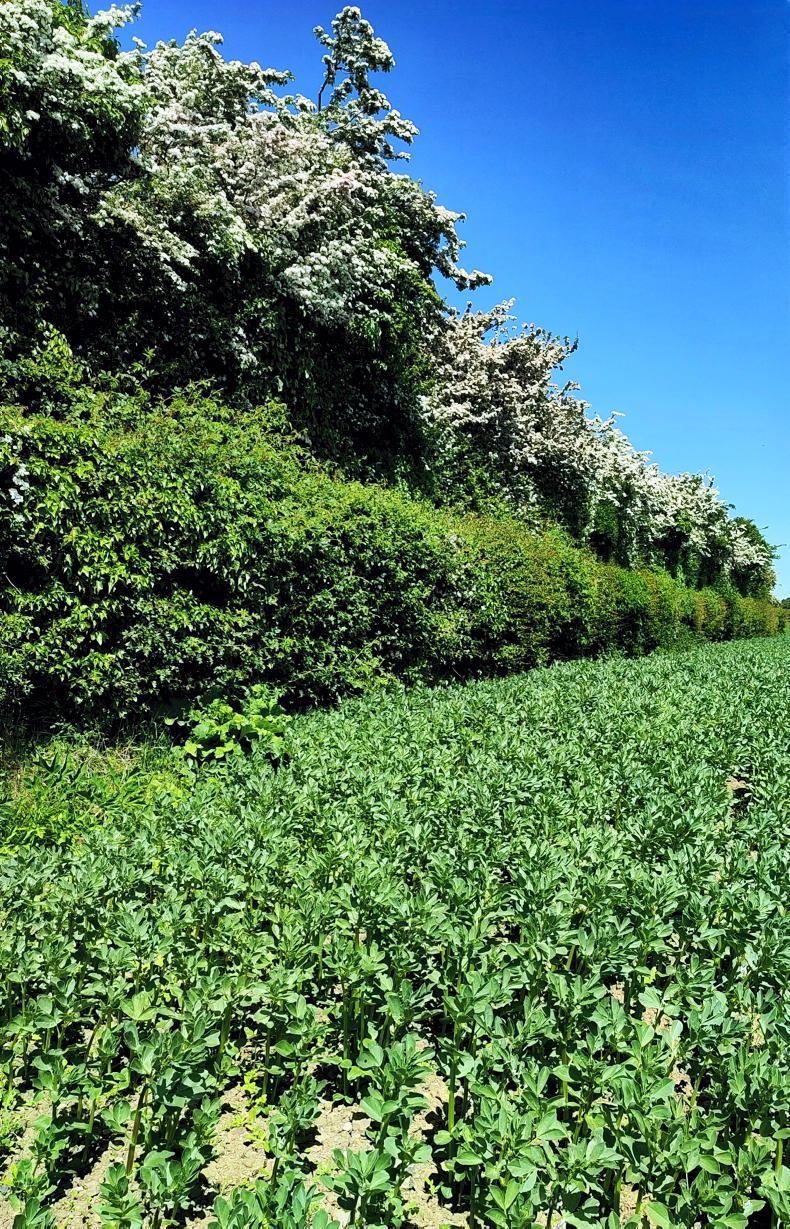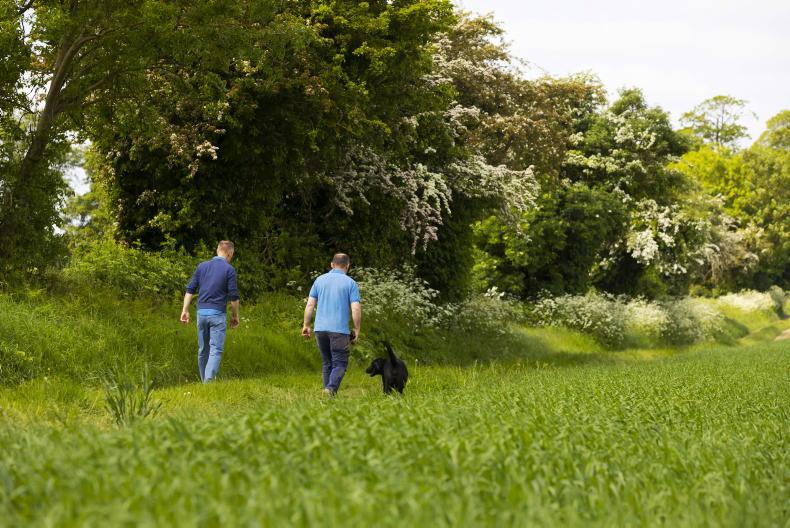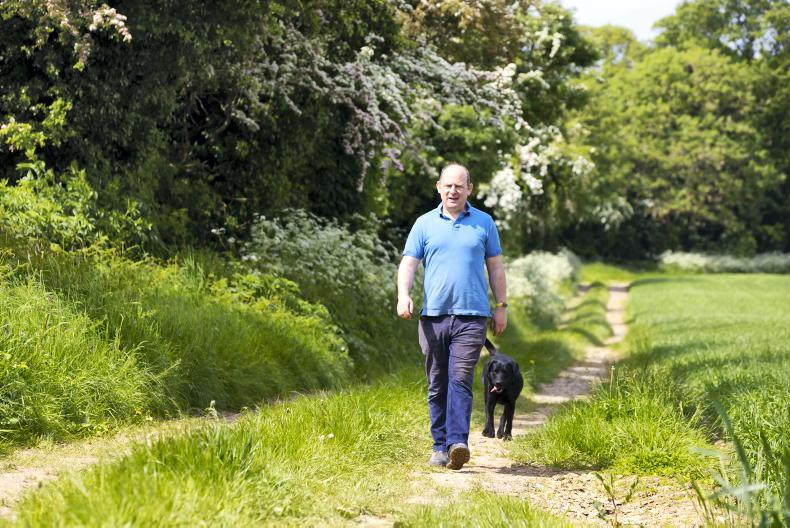Tom Butler, the overall winner of Tirlán’s grain awards for his crop of green feed wheat, is a tillage farmer from Bennettsbridge, Co Kilkenny. He is farming 480ac of mixed cropping and grassland, with some woodland.
The Butlers are interested in improving soil fertility and biodiversity on their farm. By allowing surrounding hedgerows to grow, the Butlers are aiding biodiversity while reaping the benefits of a prospering hedgerow.
Butler spoke to the Irish Farmers Journal about hedgerow management practices applied on the farm.
“Hedges are trimmed every two years. We trim the sides to maintain the field margins but we allow the hedges to grow a few centimetres every year. This allows aspects of the hedges, such as trees, to continue growing.”
Tom noted the importance of maintaining hedgerows. “Planting multispecies in gaps is important to rejuvenate the hedge. This also maintains the natural corridors and promotes habitation of insects and larger mammals such as foxes and hedgehogs.

Hedgerows on Tom Butler's farm.
“Creating a habitat suitable for insects and wildlife is really important, as insects such as ladybugs and lacewings, act as our main pollinators. They also act as a biological control for pests such as aphids, which cause damage to crops. As the cost of aphicides has increased significantly over the last year, finding natural alternatives for pest control is sustainable and cost-effective.”
Dr Alan Moore of Hedgerows Ireland shed light on the positive impact of hedgerows on crop management, pest control, and overall farm sustainability.

Dr Alan Moore of Hedgerows Ireland and Tom Butler walking through a field of gluten-free oats. \ Patrick Browne
“Establishing flourishing hedgerows on the farm has a multitude of benefits. From providing shelter and habitat for a diverse amount of wildlife to aiding in carbon sequestration, hedgerows play a vital role in maintaining a healthy ecosystem.”
Hedgerow diversity
Moore emphasised the importance of maintaining multispecies within hedgerows.
“Cultivating different varieties of plants within hedgerows supports biodiversity and adds to the habitats of many insects, birds and mammals. We should include species such as hawthorn [whitethorn] and cow parsley. We should also include trees like oak, which is a biodiversity hotspot.”
Moore expressed concern about the limited forest cover in the country and highlighted the role hedgerows play in carbon sequestration. For example, he suggested that taller and wider hedgerows could sequester more carbon, while also providing habitats and promoting biodiversity.
“Hedgerows harbour a vast array of biodiversity, including native flowering plants, which are crucial for sustaining various species,” he said.
Ash dieback, a disease affecting the most common tree species found in Irish hedgerows, is a significant problem in Ireland, Moore added.
To address this, he suggested interplanting hedgerows with a mix of species, including whitethorn, oak, hazel and spindle to enhance diversity and ensure long-term sustainability.
Butler aims to grow high-yielding crops and has premium crops and his farm acts as an example of how a farm can continue to be productive while supporting biodiversity.

Tom Butler on his farm in Bennettsbridge, Co Kilkenny.\ Patrick Browne
Beyond the aesthetic appeal of hedgerows, they provide essential ecosystem services, including pest control, carbon sequestration, and biodiversity preservation.
Moore concluded by saying: “By adopting sustainable practices and diversifying hedgerow species, farmers can contribute to a healthier environment while reaping the rewards of improved crop management and long-term sustainability.”
Tom Butler, the overall winner of Tirlán’s grain awards for his crop of green feed wheat, is a tillage farmer from Bennettsbridge, Co Kilkenny. He is farming 480ac of mixed cropping and grassland, with some woodland.
The Butlers are interested in improving soil fertility and biodiversity on their farm. By allowing surrounding hedgerows to grow, the Butlers are aiding biodiversity while reaping the benefits of a prospering hedgerow.
Butler spoke to the Irish Farmers Journal about hedgerow management practices applied on the farm.
“Hedges are trimmed every two years. We trim the sides to maintain the field margins but we allow the hedges to grow a few centimetres every year. This allows aspects of the hedges, such as trees, to continue growing.”
Tom noted the importance of maintaining hedgerows. “Planting multispecies in gaps is important to rejuvenate the hedge. This also maintains the natural corridors and promotes habitation of insects and larger mammals such as foxes and hedgehogs.

Hedgerows on Tom Butler's farm.
“Creating a habitat suitable for insects and wildlife is really important, as insects such as ladybugs and lacewings, act as our main pollinators. They also act as a biological control for pests such as aphids, which cause damage to crops. As the cost of aphicides has increased significantly over the last year, finding natural alternatives for pest control is sustainable and cost-effective.”
Dr Alan Moore of Hedgerows Ireland shed light on the positive impact of hedgerows on crop management, pest control, and overall farm sustainability.

Dr Alan Moore of Hedgerows Ireland and Tom Butler walking through a field of gluten-free oats. \ Patrick Browne
“Establishing flourishing hedgerows on the farm has a multitude of benefits. From providing shelter and habitat for a diverse amount of wildlife to aiding in carbon sequestration, hedgerows play a vital role in maintaining a healthy ecosystem.”
Hedgerow diversity
Moore emphasised the importance of maintaining multispecies within hedgerows.
“Cultivating different varieties of plants within hedgerows supports biodiversity and adds to the habitats of many insects, birds and mammals. We should include species such as hawthorn [whitethorn] and cow parsley. We should also include trees like oak, which is a biodiversity hotspot.”
Moore expressed concern about the limited forest cover in the country and highlighted the role hedgerows play in carbon sequestration. For example, he suggested that taller and wider hedgerows could sequester more carbon, while also providing habitats and promoting biodiversity.
“Hedgerows harbour a vast array of biodiversity, including native flowering plants, which are crucial for sustaining various species,” he said.
Ash dieback, a disease affecting the most common tree species found in Irish hedgerows, is a significant problem in Ireland, Moore added.
To address this, he suggested interplanting hedgerows with a mix of species, including whitethorn, oak, hazel and spindle to enhance diversity and ensure long-term sustainability.
Butler aims to grow high-yielding crops and has premium crops and his farm acts as an example of how a farm can continue to be productive while supporting biodiversity.

Tom Butler on his farm in Bennettsbridge, Co Kilkenny.\ Patrick Browne
Beyond the aesthetic appeal of hedgerows, they provide essential ecosystem services, including pest control, carbon sequestration, and biodiversity preservation.
Moore concluded by saying: “By adopting sustainable practices and diversifying hedgerow species, farmers can contribute to a healthier environment while reaping the rewards of improved crop management and long-term sustainability.”









 This is a subscriber-only article
This is a subscriber-only article











SHARING OPTIONS: